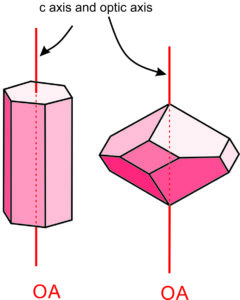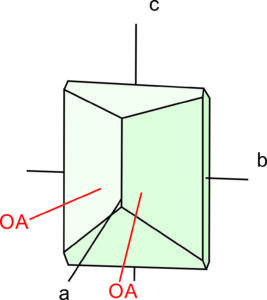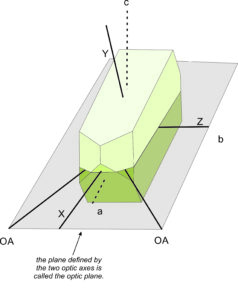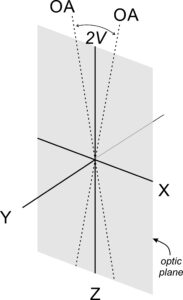5.5: More About Uniaxial and Biaxial Minerals
- Page ID
- 17588
[In the discussion below, references are made to crystal systems and to crystallographic axes. But we do not talk about them in detail until later in this book. The interested reader will come back and read this section after having read Chapter 11.]
As described earlier in this chapter, if a crystal is oriented so that the optic axis is perpendicular to the microscope stage, light passing through the crystal travels parallel to the optic axis and behaves as if the crystal were isotropic. There is no double refraction and the polarization direction of the light is not changed by interaction with the crystal. If we view the crystal with the upper polarizer inserted (XP light) the grain will remain extinct even if we rotate the stage.
Most crystals in thin section, however, will not have optic axis vertical and we will see optical properties that relate to the crystal system of the mineral. For example, all minerals that have crystals belonging to the cubic crystal system are isotropic. They have the same light velocity and therefore the same refractive index (n) in all directions. The table below compares optical parameters and properties for isotropic, uniaxial, and biaxial minerals. Isotropic crystals have a single index of refraction (n) and their birefringence is zero.
| Indices of Refraction and Birefringence in Isotropic and Anisotropic Crystals | |||||
| principle indices of refraction | index of refraction parallel to an optic axis | indices of refraction in a random direction | birefringence in a random direction | maximum possible birefringence | |
| isotropic crystals uniaxial crystals biaxial crystals |
n ω, ε α, β, γ |
n ω β |
n ω, εˈ αˈ, γˈ |
0 δˈ = ∣ω – εˈ∣ δˈ = ∣γˈ – αˈ∣ |
0 δ = ∣ω – ε∣ δ = ∣γ – α∣ |

All minerals with crystals that belong to the tetragonal or hexagonal crystal systems are uniaxial, meaning that they have only one optic axis. In these crystals, the optic axis is coincident with the c crystallographic axis (Figure 5.58), and in many uniaxial minerals, the optic axis is parallel or perpendicular to crystal faces. In uniaxial crystals, refractive index varies between two limiting values, that we designate epsilon (ε) and omega (ω). The maximum value of birefringence in uniaxial crystals is the absolute value of the difference between ω and ε (see the table above): δ = |ω – ε|. We can only see maximum birefringence (which corresponds with maximum retardation) if the optic axis is parallel to the microscope stage.
Light traveling parallel to the single optic axis of a uniaxial mineral travels as an ordinary ray and has refractive index ω. Light traveling perpendicular to the optic axis has refracted index ε. Unless traveling parallel to the optic axis, light is doubly refracted, splitting into two rays with one having refractive index ω. The other ray has refractive index εʹ, which varies depending on the direction of travel. εʹ may have any value between ω and ε.
We divide uniaxial minerals into two classes: if ω < ε, the mineral is uniaxial positive ( + ). If ω > ε , the mineral is uniaxial negative (-). We can use the mnemonic POLE (positive = omega less than epsilon) and NOME (negative = omega more than epsilon) to remember these relationships. Positive minerals are often described as having a positive optic sign; negative minerals have a negative optic sign.

Biaxial minerals include all minerals that have crystals belonging to the orthorhombic, monoclinic, or triclinic systems. Biaxial crystals, such as the one shown in Figure 5.59, have two optic axes, and the axes are not coincident with crystallographic axes (a, b, or c). Like uniaxial crystals, biaxial crystals have refractive indices that vary between two limiting values. But, unlike uniaxial minerals, both limiting values change with changes in crystal orientation relative to the light source.

As with uniaxial crystals, light passing through a biaxial crystal experiences double refraction unless it travels parallel to an optic axis. We describe the optical properties of biaxial minerals in terms of three mutually perpendicular directions: X, Y, and Z (Figure 5.60).
The vibration direction of the fastest possible ray is designated X, and that of the slowest is designated Z. The indices of refraction for light vibrating parallel to X, Y, and Z are α, β, γ. α is therefore the lowest refractive index, and γ is the highest. β, having an intermediate value, is the refractive index of light vibrating perpendicular to an optic axis.
We divide biaxial minerals into two classes based on their refractive indices. In biaxial positive minerals, the intermediate refractive index β is closer in value to α than to γ. In biaxial negative minerals, it is closer in value to γ. Retardation and apparent birefringence vary with the direction light travels through a biaxial crystal, but the maximum value of birefringence (δ) in biaxial crystals is always γ – α. See the table above for descriptions of other parameters.
In orthorhombic crystals the optical directions X, Y, and Z correspond to crystal axes (a, b or c). But, it is not a one-to-one correspondence because the X direction can be either a, b, or c. The same holds for Y and Z. In monoclinic crystals either X, Y, or Z are the same as the b axis. For example, Figure 5.60 shows a monoclinic orthoclase crystal where z is equivalent to b. The other two optical directions do not correspond to crystal axes – but in many monoclinic crystals are close. In triclinic crystals there is no correspondence between optical axes and crystallographic axes.
Normally, light passing through a randomly oriented biaxial crystal is split into two rays, neither of which is constrained to vibrate parallel to X, Y, or Z, so their refractive indices will be some values between α and γ. However, if the light is traveling parallel to Y, the two rays have refractive indices equal to α and γ, vibrate parallel to X and Z, and the crystal will display maximum retardation. If the light travels parallel to an optic axis, no double refraction occurs, and it has a single refractive index, β. There is no birefringence or retardation and the mineral appears extinct.

In biaxial minerals, we call the plane that contains X, Z, and the two optic axes the optic plane (Figures 5.60 and 5.61). The acute angle between the optic axes is 2V. A line bisecting the acute angle must parallel either Z (in biaxial positive crystals) or X (in biaxial negative crystals). We can measure 2V with a petrographic microscope and it can be an important diagnostic property. The feldspar in Figure 5.60 is biaxial negative but the drawing in Figure 5.61 is for a positive crystal.


